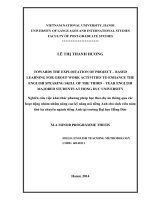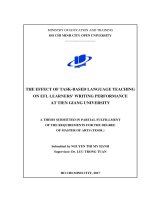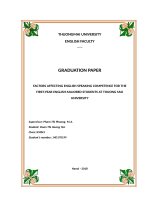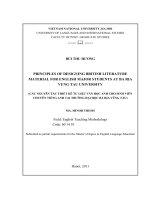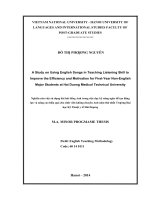Factors affecting learning engagement for task based language learning of non english majored students at ba ria vung tau university master of TESOL
Bạn đang xem bản rút gọn của tài liệu. Xem và tải ngay bản đầy đủ của tài liệu tại đây (1.21 MB, 100 trang )
MINISTRY OF EDUCATION AND TRAINING
BA RIA VUNG TAU UNIVERSITY
---------------
THESIS
VU THI MINH TAM
FACTORS AFFECTING LEARNING ENGAGEMENT FOR TASKBASED LANGUAGE LEARNING OF NON-ENGLISH MAJORED
STUDENTS AT BA RIA VUNG TAU UNIVERSITY
Ba Ria-Vung Tau 2022
MINISTRY OF EDUCATION AND TRAINING
BA RIA VUNG TAU UNIVERSITY
---------------
THESIS
FACTORS AFFECTING LEARNING ENGAGEMENT FOR TASKBASED LANGUAGE LEARNING OF NON-ENGLISH MAJORED
STUDENTS AT BA RIA VUNG TAU UNIVERSITY
Submitted to the Postgraduate Institute in partial fulfillment
of the Master’s degree in TESOL
Course code: 8140111
By
Vu Thi Minh Tam
Supervised by
Tran Quoc Thao, Ph.D.
Ba Ria-Vung Tau 2022
The thesis entitled FACTORS AFFECTING LEARNING ENGAGEMENT FOR
TASK-BASED LANGUAGE LEARNING OF NON-ENGLISH MAJORED
STUDENTS AT BA RIA VUNG TAU UNIVERSITY was successfully defended and
approved on April 24th at Ba Ria Vung Tau University (BVU).
Academic supervisor: Dr. TRAN QUOC THAO
Examination Committee
1. ………………………………………………………. Chair
2. ……………………………………………. ………… Reader 1
3. ………………………………………………………. Reader 2
4. ………………………………………………………. Member
5. ……………………………………………………….. Secretary Member
On behalf of the Examination Committee
Chair
(full name, title, signature)
BA RIA VUNG TAU UNIVERSITY
POSTGRADUATE INSTITUTE
Ba Ria Vung Tau, December 2021
MASTER’S THESIS REPORT
Student name: VU THI MINH TAM
Sex: Female
Date of birth: 18/01/1992
Place of birth: Ba Ria Vung Tau Province: Vung Tau
Major: English Language
Student code: 18110049
I- Thesis title:
FACTORS AFFECTING LEARNING ENGAGEMENT FOR TASK-BASED
LANGUAGE LEARNING OF NON-ENGLISH MAJORED STUDENTS AT BA
RIA VUNG TAU UNIVERSITY
II-Objectives and contents:
This study aims at exploring the factors that affect the learning engagement for TBLT of
non-English-majored students in the context of BVU. The specific objectives of the
research are as follows:
To determine the learning engagement for TBLT of non-English-majored students at BVU.
To find out the factors that affect learning engagement for TBLT of non-English-majored
students at BVU.
To examine if there is any significant relationship in the learning engagement for TBLT
and the factors affecting learning engagement for TBLT of non-English-majored students
at BVU.
This study is conducted at BVU in Vung Tau city. There are over 4000 students with
different abilities. For those who are not specialized in English, completing the 6 courses
of learning English with LIFE course-book is compulsory for their graduation. Therefore,
the participants of this study are the 200 non-English-major students who are using this
textbook as well as having chances of studying different topics and experiencing TBLT in
classrooms. To achieve the desired results, the researcher conducts a semi-structured
interview and delivers questionnaires to the participants to collect data. Besides, the mixed
methods design is employed, and two analytical methods utilized are SPSS and content
analysis.
III- Starting date: (as stated in the Decision issued by the University)
IV- Completing date:
..............................................................................................................
V- Academic supervisor: (full name,title)
TRAN QUOC THAO, Ph.D.
ACADEMIC SUPERVISOR
SCHOOL HEAD
((full name, signature)
((full name, signature)
CERTIFICATE OF ORIGINALITY
I certify my authorship of the Master’s Thesis submitted today entitled:
FACTORS AFFECTING LEARNING ENGAGEMENT FOR TASK-BASED
LANGUAGE LEARNING OF NON-ENGLISH MAJORED STUDENTS AT BA
RIA VUNG TAU UNIVERSITY
In terms of the statement of requirements for Theses in Master’s programs issued by
Higher Degree Committee of Postgraduate Institute, Ba Ria Vung Tau University
Ba Ria Vung Tau province, December 2021
VU THI MINH TAM
RETENTION AND USE OF THE THESIS
I hereby state that I, Vu Thi Minh Tam, being a candidate for the degree of TESOL accept
the requirements of the University relating to the retention and use of Master’s Theses
deposited in the Library.
In terms of these conditions, I agree that the original of my Master’s Thesis deposited in
the Library should be accessible for purposes of study and research, in accordance with the
normal conditions established by the Librarian for the care, loan, and reproduction for
theses.
Ba Ria Vung Tau, December 2021
Signature ……………………
Vu Thi Minh Tam
ACKNOWLEDGEMENTS
I would like to express my sincere thanks to those who have made great contributions to
my thesis completion.
First and foremost, I would like to express my profound gratitude to Dr. Tran Quoc Thao,
my supervisor, for his valuable comments and suggestions during the whole research
process. His dynamism, enthusiasm, vision as well as his patience have deeply inspired
me. Without his support and guidance, this thesis would never have been completed.
Secondly, I am very grateful to the school board staff including the principal and the
Postgraduate Institute of Ba Ria – Vung Tau University who have given me
encouragement, support of time and finance, and permission to complete the MA course
and implement this thesis there.
My sincere thanks also go to my friends and colleagues for all their help and motivation. I
would like to thank the research participants who have contributed to this study.
Last but not least, I warmly thank my family for their countless support, greatest sympathy,
and unconditional love who have provided me strong spiritual and material support.
ABSTRACT
It is universally acknowledged that Task-based Language Teaching (TBLT) plays an
integral role in the language teaching and learning process. In many countries all over the
world, TBLT is applied to the process of teaching and learning English widely and
effectively. Nevertheless, when it comes to the context of education in Vietnam, especially
the English subject, examinations are mainly grammar focused. Hence, English teaching
and learning is purely examination-based. This leads to the fact that students lose their
interest in acquiring the new language and fail to speak fluent English. Therefore, the main
aim of this paper is to explore the factors that affect the learning engagement for TBLT of
non-English-majored students at Ba Ria Vung Tau University (BVU). This study involves
200 non-English-major students who are using this textbook as well as having chances of
studying different topics and experiencing TBLT in classrooms taking part in answering
the questionnaire and sixty students in responding to the semi-structured interview
questions. The data gained from the questionnaire are analyzed by SPSS in terms of
descriptive statistics (means, standard deviation, & frequency). The findings of the study
show that teacher-related, learning context-related and learner-related factors have positive
impacts on learning engagement for TBLT. The researcher then analyzes the data taken
from the semi-structured interview to make the results of the study clearer. These
preliminary findings are hoped to contribute to a better understanding of the current
perspectives of the factors that affect the learning engagement for TBLT, with a view to
bringing some practical implications in the Vietnamese context, thereby improving the
quality of the teaching in English language for non-majored English students in Ba Ria
Vung Tau university in specific and Vietnam in general. (280 words)
Keywords: TBLT, factors, learning engagement, non-English majored students.
TABLE OF CONTENT
CHAPTER 1: INTRODUCTION ............................................................................. 1
1.1. Background to the study .................................................................................. 1
1.2. Statement of the problem ................................................................................... 3
1.3. Aims of the Study ............................................................................................... 5
1.4. Research questions ............................................................................................. 5
1.5. Scope of the study .............................................................................................. 6
1.6. Significance of the study .................................................................................... 6
1.7. Definitions of the Terms .................................................................................... 7
1.8. Organization of the study ................................................................................... 7
CHAPTER 2: LITERATURE REVIEW .................................................................. 8
2.1. Introduction ........................................................................................................ 8
2.2. An overview of TBLT ........................................................................................ 8
2.3. Tasks in TBLT ................................................................................................... 9
2.3.1. Definitions of tasks ...................................................................................... 9
2.3.2. Types of tasks............................................................................................. 11
2.4. Learning engagement ....................................................................................... 14
2.5. Factors affecting learning engagement for TBLT ........................................... 17
2.5.1. Learner-related factors ............................................................................... 17
2.5.2. Teacher-related factors ............................................................................... 21
2.5.3. The learning context-related factors .......................................................... 24
2.6. Previous studies ................................................................................................ 26
2.7. Conceptual framework ..................................................................................... 30
2.8. Summary .......................................................................................................... 31
CHAPTER 3: METHODOLOGY .......................................................................... 32
3.1. Research design ............................................................................................. 32
3.2. Research context and Participants .................................................................... 32
3.3. Research instruments........................................................................................ 35
3.3.1. Questionnaire ............................................................................................. 35
3.3.2. Semi-structured interview ....................................................................... 36
3.4. Data collection and analysis procedures .......................................................... 37
3.4.1. Data collection procedure .......................................................................... 37
3.4.2. Data analysis procedure ............................................................................. 37
3.5. Reliability and validity of the questionnaire .................................................... 38
3.6. Summary .......................................................................................................... 39
CHAPTER 4: RESULTS AND DISCUSSIONS.................................................... 40
4.1. Results .............................................................................................................. 40
4.1.1. The learning engagement for TBLT of non-English-majored students at
BVU ..................................................................................................................... 40
4.1.2. The factors affecting the learning engagement for TBLT of non-Englishmajored students at BVU ..................................................................................... 42
4.1.3. How non-English-majored students’ learning engagement for TBLT
correlates with the factors affecting their learning engagement for TBLT ......... 48
4.2. Discussions of the findings .............................................................................. 49
CHAPTER 5. CONCLUSION ................................................................................ 53
5.1 Summary of the main findings of the study ...................................................... 53
5.2 Pedagogical implications .................................................................................. 54
5.3 Limitations ........................................................................................................ 55
5.4 Recommendations for the further research ....................................................... 56
REFERENCES ........................................................................................................ 58
APPENDIX 1 .......................................................................................................... 67
APPENDIX 2 .......................................................................................................... 72
APPENDIX 3 .......................................................................................................... 74
APPENDIX 4 .......................................................................................................... 78
APPENDIX 5 .......................................................................................................... 81
APPENDICES
Appendix 1: Questionnaire for Students
Appendix 2: Interview Protocol
Appendix 3: Cronbach’s Alpha
Appendix 4: Contents of LIFE coursebook
Appendix 5: A TBLT Lesson plan
LIST OF ABBREVIATIONS AND SYMBOLS
TBLT
Task-based language teaching
BVU
Ba Ria Vung Tau university
LIST OF TABLES
Table 3.1
Frequency of survey participants’ personal information
34
Table 4.1
Total mean scores of learning engagement for TBLT
41
Table 4.2
Learning engagement for TBLT
41
Table 4.3
Total mean scores of learner-related factors
42
Table 4.4
Learner-related factors
43
Table 4.5
Total mean scores of learning context-related factors
44
Table 4.6
Learning context-related factors
45
Table 4.7
Total mean scores of teacher-related factors
46
Table 4.8
Teacher-related factors
46
Table 4.9
Correlations
48
CHAPTER 1 : INTRODUCTION
1.1.
Background to the study
It is clearly evident that English is the greatest language spoken universally when
one out of five people can speak or at least understand it. According to Crystal
(1997), it is estimated that there are 380 million native speakers and 300 million that
utilize English as a second language and an additional 100 million who use it as a
foreign language. Furthermore, Graddol (1997) states that English has also been
considered the language of science, aviation, computers, diplomacy, and tourism. In
terms of knowledge, English is a major window that helps people get information
and broaden their horizons. It indicates that without English, one can hardly attain
the amount of information he needs if he wants to conduct research himself. In
addition, in this modern era, as a global language, there is no denying that English
plays a vital role in international interactions which include economic relationships
among countries, international business relationships, global trading, and others.
According to Sneddon (2003), English mainly acts as a global lingua franca that is
used to communicate among different people from different countries.
Consequently, having a good command of English is undoubtedly of necessity as it
is the key to unlock one’s highest potential in the future world.
As the number of English learners is increasing, different teaching methods have
been implemented to evaluate the effectiveness of the teaching progress. For many
decades, language teaching and learning have been dominated by grammar- based
approaches with traditional classroom activities. However, these methods of
teaching have received little demand. As a reaction to this matter, a notion of
communicative competence was developed. The approach later came to be known
as Communicative language teaching (CLT). Task-based Language Teaching
(TBLT), on the other hand, does not have a clear definition, but some proponents
present it as the logical development of CLT because its basic principles were
derived from the CLT movement of the 1980s (Littlewood, 2007). TBLT is an
approach that provides students with opportunities to engage actively in
1
communication to achieve a goal or complete a task. The use of this method in class
usually brings real-life work that allows the practice of all the language abilities,
especially speaking. Ellis (2009) points out that this methodology focuses on the
integration of language learning where students are expected to conduct creative
activities, infer meaning from readings and oral messages, and communicate their
ideas well. Thus, learners themselves are put in a real situation where oral
communication is needed. In addition, Willis (1996) focuses on the importance of
this approach because it emphasizes authenticity and communicative activities. For
them, when TBLT is applied in class, learners are assigned active roles while
learning and reflections are constant. Hence, it is obvious that TBLT enhances
students’ communicative competence with the use of authentic language, daily-life
activities, and the chance of practicing the target language constantly.
In Vietnam, as Le (2007) states that since the economic and political reforms were
launched in 1986, English has been regarded as a vital foreign language. As the
number of foreign people coming to Vietnam to work and invest has dramatically
been increasing, the significance of English has been widely recognized by not only
the government but also its citizens. The growth of international businesses and trade
has motivated Vietnamese people to improve their language skills among their
counterparts. Consequently, English has become a compulsory subject at secondary
schools, followed by high schools, colleges, and eventually universities around the
country. There has also been a boom in language centers across the country. The
main concern of teaching English to students at secondary school and primary school
is mostly on grammar, vocabulary as well as sentence structures while
conversational English is not fully taken into consideration. Besides, examinations
are mainly grammar focused. Hence, English teaching and learning is purely
examination-based. This leads to the fact that students gradually lose their interest
in acquiring the new language and fail to speak fluent English. When it comes to the
university level, the progress of teaching and learning English seems much positive
when students have more chances to produce the language and improve the skills
equally.
2
In recent years, there have been a lot of changes and improvements in teaching
methodologies at Ba Ria-Vung Tau University (BVU), especially in the area of the
communicative approach. Teachers pay more attention to apply and integrate
communicative lessons into the English learning classrooms to provide students with
real-life context for the purpose of better communication. As a result, in today
classrooms, it can be seen that more and more learners’ responses take place.
However, when the non-English-majored students here need to express their ideas
and thoughts in English, they fail to develop their English-speaking competence,
making themselves misunderstood in many circumstances. Thus, to most of the nonEnglish majored students at BVU, English is not an easy subject.
1.2. Statement of the problem
The non-English-majored students at BVU are studying the course book LIFE
presented by National Geographic. LIFE is a general English course with six levels.
It consists of a full package which is really useful. For students, they can make full
use of student’s books, online homework, and workbooks at the same time. Besides,
as for teachers, they can take advantage of teacher’s books, extra materials from the
websites, especially interactive whiteboard, and the assessment CD-ROM.
Normally, one book is used for 2 semesters for students from beginners to students
of B1 level according to the Common European Framework of Reference for
Languages (CEFR). When taking the English courses, students are provided with a
wide range of practical and appropriate communicative tasks that help them in
developing vocabulary, pronunciation, grammar, functions, and skills. From
different themes and context, vocabulary can be easily taught with an emphasis on
key words and word formation in Word focus and Word building sections. In
addition, students have a lot of opportunities to put themselves in real-life
circumstances and practice daily functions which prepare them a firm base from
which they can use English in the real world. However, it is obvious that the nonEnglish-major students here encounter a lot of obstacles while studying this second
language.
3
First and foremost, students face challenges in English speaking skills. Le (2011)
also examines her research in the same context and points out that the challenges
they encounter are due to their learning styles, worries, and language proficiency.
When students lack linguistic competence, they do not have enough vocabulary to
fully express their ideas in English. They are confused to use the word that they need,
then beat about the bush and end up in long pauses and embarrassment. This can
lead to the fact that they are unconfident and unwilling to speak English because
they are afraid of making mistakes. Once students consider it as a negative factor
and try to avoid it as many times as possible, it will result in a lack of active and
enthusiastic participation in communicative activities in English in class, making it
harder for them to obtain the language. One of the major problems that students at
BVU
encounter
is
their
attitude
towards
learning
English.
Most of them study English from the examination point of view. They just love to
focus on the grammar features and exercises that appear in the tests without paying
much attention to using authentic language in everyday conversation. Moreover,
although they have been taught a number of new words and structures involved in
the topic given, they hardly can complete the tasks related to daily context.
Another hindering factor to the learning progress of the non-English-majored
students at BVU is that they are familiar with the traditional learning methods. In
fact, throughout school-years at secondary and high school, students have been
accustomed to lecture-style and rote learning which remains the dominant practice.
Teacher-centered approaches are the norm, and students seemed conditioned to
receive knowledge passively. As a result, students lack confidence in applying
learning to practice. When it comes to English, students keep following the same
way, making it hard for them to apply the language they have learnt effectively in
real situations. Moreover, it is also a big challenge for students to shift from the
traditional methods to the new ones such as TBLT, which forces students to make
more attempts and efforts in learning.
The fact that teachers lack experience in TBLT is one of the difficult problems in
implementing TBLT in classrooms. Apparently, when applying the new teaching
4
methods, teachers need to be well-prepared for the changes in teaching
methodology. It would be a big challenge for teachers to give students good
instructions, provide them with good right answers or direct them towards the next
step they could take. However, as Hoang (2016) finds out that due to the Vietnamese
tradition of hierarchical order and respect which most Vietnamese learners are
expected to live by seems to have a strong impact on students to such a degree that
many of them are actually unable to take any initiative at all.
In short, there has been a lot of research across many contexts, especially Asian
recently to name the challenges posed to English teachers in using TBLT. However,
little research has been undertaken to investigate the factors that affect learning
engagement for task-based learning of students at universities based on the obstacles
they face, which is a gap that this study seeks to fill.
1.3. Aims of the Study
This study aims at exploring the factors that affect the learning engagement for
TBLT of non-English-majored students in the context of BVU. The specific
objectives of the research are as follows:
• To determine the learning engagement for TBLT of non-English-majored
students at BVU.
• To find out the factors that affect learning engagement for TBLT of nonEnglish-majored students at BVU.
• To examine if there is any significant relationship in the learning
engagement for TBLT and the factors affecting learning engagement for
TBLT of non-English-majored students at BVU.
1.4. Research questions
In order to achieve the aforementioned objectives, the following research questions
must be addressed:
1. To what extent is the learning engagement for TBLT of non-Englishmajored students at BVU?
5
2. What are the factors that affect the learning engagement for TBLT of nonEnglish-majored students at BVU?
3. How does non-English-majored students’ learning engagement for TBLT
correlate with the factors affecting their learning engagement for TBLT?
1.5. Scope of the study
This study is conducted at BVU in Vung Tau city. There are over 4000 students
with different abilities. For those who are not specialized in English, completing
the 6 courses of learning English with LIFE course-book is compulsory for their
graduation. Therefore, the participants of this study are the 200 non-English-major
students who are using this textbook as well as having chances of studying different
topics and experiencing TBLT in classrooms. To achieve the desired results, the
researcher conducts a semi-structured interview and delivers questionnaires to the
participants to collect data. Besides, the mixed methods design is employed, and
two analytical methods utilized are SPSS and content analysis.
1.6. Significance of the study
With the thriving innovation of education in Vietnam in terms of English, there has
been a significant change in the language teaching in this day and age. It is the major
change from the teacher-centered approach to the learner-center approach. Thanks
to this, students have the opportunity to get familiarized with the new way of
learning English. Instead of passively obtaining knowledge from the teachers,
students themselves are not only more active but also more creative in their own
learning process. It means that they have recognized the vital role of learning in the
way they master the lessons. One of the teaching approaches that strongly motivates
students is TBLT. This study is significant because it provides readers with profound
knowledge of TBLT, the obstacles that can hinder learners as well as the factors that
affecting learning engagement for task-based language learning of the non-Englishmajor students at BVU. Moreover, it is also a big stimulation to teachers when they
implement TBLT in their classrooms. Moreover, there is no denying that the study
will be beneficial to the stakeholders of BVU when the quality of teaching and
learning is getting better and better.
6
1.7. Definitions of the Terms
With a view to providing a specific understanding of the issues discussed in this
study, it is of great importance to define many terms as follows
• Factor refers to the fact or the influence that contributes to the result or the
outcome.
• Learning engagement refers to the investment and effort of students
towards their learning, understanding, or attaining their knowledge or skills.
• Non-English majored students refer to students who are studying general
English at BVU.
• Task-based language learning refers to a teaching method that was first
performed by Prabhu, who published the Bangolore research report in 1987
and advanced the concept of task-based approach (Wei, 2004). Being a
learner-centered approach, it views language as a communicative tool. Taskbased approach aims at presenting opportunities for learners to master
language both in speaking and writing via learning activities by achieving a
goal or completing a task. Such tasks are designed to help students use
authentic language including conducting a review, listing, telling stories…
1.8. Organization of the study
There are five chapters in this thesis. Chapter 1 outlines the background of the study,
aims of the study, subject and scope of the study, significance of the study and
organization of the thesis. Chapter 2 provides the literature review related to TBLT
(definitions of TBLT); tasks in TBLT (definitions of tasks, types of tasks); learning
engagement; factors affecting learning engagement for TBLT (learner-related
factors, teacher-related factors, the learning context-related factors), previous
research and conceptual framework. Chapter 3 represents the methodology to carry
out the study while chapter showed the results and discussion of the study. Finally,
chapter 5 concludes the thesis based on the findings of the study. Below is the
organization of the thesis.
7
CHAPTER 2: LITERATURE REVIEW
2.1. Introduction
Among current methods for learning English, TBLT has a real-life name “learning
by doing”. In this chapter, relevant issues of this method are presented in the
following themes: an overview of TBLT, tasks, tasks in TBLT, types of tasks,
learning engagement in a TBLT classroom, affecting factors on learning engagement
for TBLT, previous studies, conceptual framework, and summary.
2.2. An overview of TBLT
Task-based Language Teaching (TBLT) is a process-oriented language teaching
approach. It was first implemented by Prabu (1987) in his Bangalore project in India.
TBLT is a different way to teach language compared to PPP (Presentation- Practice
– Production) method as it engages learners to perform a series of tasks in an
authentic language environment (Murad, 2009). According to Richards (2005),
TBLT centralizes communicative language teaching at the heart of syllabus design
and instructional goals. This means that communicative competence is the main
objective of language teaching. During the process of learning, TBLT aims not only
to help learners acquire new linguistic language but also enrich their prior
knowledge. As pointed out by Branden, Bygate & Noris (2009), the basic focus in
this approach lies in enabling learners to use the target language for social functional
action as well as situation communication. It can help the students by placing them
in a situation where oral communication is essential for doing a specific task. With
its distinctive characteristics, TBLT has the advantages of getting students to use
their skills at their current level and learning pace, develop learners’ language
through its use, and exploit the language as an effective communication tool. All in
all, TBLT is a language learning by doing.
8
2.3. Tasks in TBLT
2.3.1. Definitions of tasks
A task is the basic unit of TBLT. The very first feature teachers must capture is to
grasp what a task is.
As cited in Larsen-Freeman (2000), Long (1985) defines a task as a type of work
carried out for oneself or for others, freely or for some kinds of reward. Examples
of tasks related to daily actions in life and at work such as painting a certain object,
dressing a person, completing a form, buying goods, booking air tickets, and
borrowing books in a library. More pedagogically, Richards (2005) considers tasks
as activities or actions that result from learners’ language processing or
understanding. Callies (2008) also calls a task a problem-solving negotiation
between learners’ previous and new knowledge. Similarly, Prabhu (1987) regards
tasks activities which require learners to arrive at an outcome from given information
through some processes of thought, but he warns that teachers are allowed to control
and regulate those processes in tasks. These definitions of tasks mentioned lack
connection with learners’ communication and target language use as recognized
today.
Larsen-Freeman (2000) describes tasks as meaningful communitive activities with
clear outcomes for students. In doing these tasks, learners have to communicate in
the target language to fulfill given assignments. This figuration of tasks is in line
with Willis’s (1996) viewpoint when she calls tasks as activities where learners used
the target language for communication to achieve an outcome. Larsen-Freeman’s
(2000) definition also fits Nunan’s (1989) focus when they state that a task of
communication in the classroom work is an activity which makes learners involved
in comprehending, manipulating, producing, or/and interacting in the target
language while their attention is principally focused on meaning rather than form. It
can be seen that features of meaningful communication, target language use and
explicit outcomes are revealed in these definitions.
9
More recently, Ellis (2009) figures tasks to be “work plan” with need-based
materials for learners to “achieve an outcome specified in communicative rather than
linguistic terms” (pp.1-2). Previously, Littlewood (2007) states that tasks are
activities in which learners are provided with purposeful contexts where they can
learn and use English for meaningful communication. In these two definitions, tasks
focus on meaning is affirmed and a new insight to learners’ needs is referred to.
Moreover, according to Bachman and Palmer (1996), a task is an activity involving
individuals in using language for the purpose of accomplishing a specific goal or
objective in a particular situation. Having the same train of thoughts, Richards and
Rodgers (2001) define a task as a conducted activity or goal using language. Hence,
the task is considered as a key feature in teaching and planning.
In general, with reference to definitions mentioned above, tasks can be understood
as meaningful communicative activities where students need to communicate for
problem-solving. They have some characteristics as follows:
- Tasks provide learners with a context so that they can negotiate and
comprehend the language provided or that used by a partner carrying out the same
task.
- Tasks provide learners with chances of getting helpful feedback on their
production, either by a partner or a teacher.
- Tasks provide learners with opportunities to communicate successfully and
discover different previous aspects that may have remained unknown or been
incompletely controlled.
- Tasks help learners notice the gap between a partner’s production and the
provided input, thereby reflecting on the form of output.
- Task requirements can concentrate on particular concepts needed for
expressions in the second language (L2) and help them in terms of grammatical
aspects as well as the accuracy of production.
10
